FIVE REASONS YOU HAVEN’T TRIED A TRI
Jarrett Pflieger
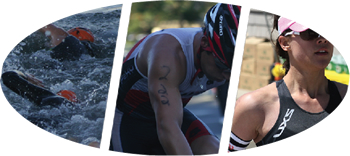
It is human nature to be scared of unfamiliar territory. We are all excellent at making excuses to keep ourselves from going out of our comfort zone and trying something new. These excuses could be keeping us from doing things that could change our lives for the better.
For many people, the idea of competing in a triathlon can be a scary thing. There are countless excuses not to try a triathlon, but even more reasons why you should. Here are some common excuses keeping people from venturing into the sport and why they may not be very good ones.
I don’t have enough time to train:
The average American spends an average of 127 hours watching television and 26 hours on the Internet per month. Even a quarter of this amount of time is more than enough to train for all three sports included in a triathlon. Depending on the distance you choose to race, you can easily get enough quality training with less than 10 hours a week.
Not to say that training for a triathlon isn’t a sacrifice, because many times you do have to give up some things, but a few less hours a week on Facebook and Twitter could make a world of difference. So turn off those reality TV shows and lace up your running shoes, in the end you will not regret it.
I’m not a (swimmer/cyclist/runner):
You do not have to already be good at all three sports, or any of them, to compete in a triathlon. Even world-class triathletes have weaknesses they must work on to even be competitive. It helps to come from a background in one of the three sports, but there are plenty of excellent triathletes that had no prior experience in any of the sports before doing their first triathlon. You may have to put in more time in one or two of the sports to get them up to par with the others, but a good coach and training plan can definitely get you there.
I’m too out of shape:
All the more reason to try a triathlon. There are people of all different ages, shapes, and sizes competing in triathlons. Anyone can do it if they start slow and build their fitness up one step at a time. If you go out too hard, too fast, you may get burned out before your body has time to catch up. Again, a good training plan and a coach can help you progress at a rate that is appropriate for your abilities.
I’m scared of not finishing:
Not finishing is always a possibility. Flat tires, crashes, and injuries have kept even the best triathletes from the finish line. There are certain things you can’t control, but one thing you can control is how you prepare. Put the time in, put your miles in, and you won’t have to worry about your fitness being what keeps you from finishing. Even if you don’t finish, you still did what 99% of people have never done. You stepped up to the starting line of a triathlon and gave it all you had.
I have no idea where to start
There are an infinite number of resources to help you start your triathlon journey. Check out websites like, www.triathica.com www.beginnertriathlete.com or many others dedicated to helping new athletes figure out what they need to do to succeed. There are thousands of books dedicated to the subject as well including Triathica’s Triathlon Roadmap as well.
You can also join your local triathlon club to find training partners, get advice, and ask questions. Find a certified triathlon coach to help you create a custom training plan based on your abilities and available training time. There is no shortage of information on how to start training for a triathlon if you know where to find it. So get out there and try something new. Even if you only do one race, it is something you carry with you forever.
PERIODIZING YOUR NUTRITION
Jarrett Pflieger
Successful triathletes know that periodizing their training is the key to getting the best results possible. Periodization is defined as the “progressive cycling of various aspects of a training program during a specific period of time.” When an athlete periodizes their training, they basically break down their training year into smaller cycles. Each cycle’s goal is different and works on a different aspect of a triathlete’s performance. One cycle may be to focus on longer and slower distances to increase endurance, while another cycle may focus on higher intensity efforts to raise an athlete’s lactate threshold and enable them to go faster while fatiguing less.
When an athlete changes up their training like this, their nutritional requirements also change. In order to get the most out of training, the foods you eat should change along with your training. How does this work?
Once we start thinking about food as fuel, it becomes clearer. When you are in your highest volume of training, your body needs extra fuel to give your body the energy it needs to get through your workouts. When in the offseason or a lower volume cycle, the goal should be eating clean foods and managing or losing any extra weight.
Many athletes make the mistake of trying to lose a few extra pounds before a race, but this is when you need to be keeping your body adequately fueled by eating more. The time to lose weight is not in the cycle leading up to the race, but much earlier during offseason or a low intensity cycle far out from your race.
Here are a few guidelines to help you periodize your nutrition along with your training:
– If you need to lose extra weight, stick with a high lean protein diet with lots of fruits and vegetables. Keep carbohydrate intake to a minimum. This should only be done far out from a race when training volume is low.
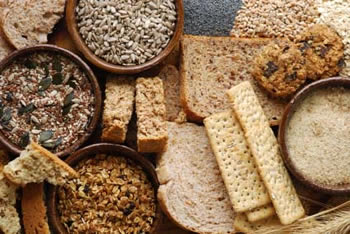 – When your training starts to increase during a build phase, begin to incorporate more whole grains and complex carbohydrates into your diet. Stick with whole wheat bread, brown rice, oatmeal, etc. Try to stay away from processed carbs, sugars, and fatty foods. Make sure to indulge every once in a while, but don’t overdo it.
– When your training starts to increase during a build phase, begin to incorporate more whole grains and complex carbohydrates into your diet. Stick with whole wheat bread, brown rice, oatmeal, etc. Try to stay away from processed carbs, sugars, and fatty foods. Make sure to indulge every once in a while, but don’t overdo it.
– During your race phase, make sure you are taking in plenty of complex carbs to fuel your intense workouts. This is not the time to go on a diet and limit your calories.
– Just listen to your body and increase caloric intake slowly to discourage rapid weight gain. If you are not hitting your goal times and have trouble completing longer distance workouts, you might not be eating enough. If you start gaining weight rapidly, you may be eating too much.
A certified dietitian can help you create a custom nutrition plan. If you need some help creating a periodized training plan, consult a certified triathlon coach. Get your nutrition plan on pace with your training plan and you will be surprised at what you can do.
RACE REPORT: SAN DIEGUITO HALF MARATHON
Ron Saetermoe
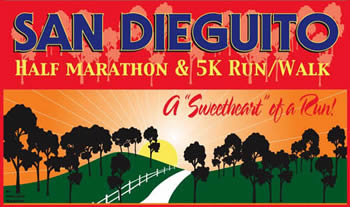
Until a couple weeks ago I’d never heard of the San Dieguito Half Marathon. That’s the problem with living in paradise – there are so many great options.
As you know, I’m into my Ironman training now, and as part of that I love the half marathon race distance. The distance really seems to help build speed and endurance without trashing you for a couple weeks.
San Dieguito is down in Rancho Santa Fe in San Diego County just east of Solana Beach. The area is beautiful with lots of trees and hills. Seven of us carpooled down there, which was fun in itself. Since we had a woman on board we were all on our best behavior (no farting!).
The weather was perfect and San Dieguito Park was beautiful. Truly a great place for a picnic if you’re looking to get away.
The race starts down the hill from San Dieguito Park and winds through the streets of Rancho Santa Fe, over the aforementioned hills. Hills at times that didn’t seem to have an end!
Scott (Scooter) Callender and Larry (Lar Dog) Davidson set the pace for our group. I started to run with Gary Clendenin but couldn’t hang with him.
At about mile two I saw Lar Dog off on the left side of the road working on his foot. He had a sharp pain in the top of his foot that forced him to stop. After about a minute he’d fixed the problem and promptly blew by me.
Shortly after that I passed Gary at one of the aid stations. I didn’t look back but thought he was just behind me. It wasn’t until later that I saw he’d dropped back a bit.
Since I loaded my legs from a 50+ mile bike ride the day before with Stu Lowndes into Huntington Beach I was hurting the entire way (RPE 10). There were opposing forces at work. My legs ached so they didn’t want to go fast but my heart rate was also up because I’d trashed myself the day before. Either way there wouldn’t be a PR in it for me today.
Everyone had a great time but Scooter absolutely killed this really tough course!
Scott Callender: 1:30:58 (6:57)
Larry Davidson: 1:33:55 (7:10)
Ron Saetermoe: 1:37:23 (7:26)
Kari Krause: 1:37:28 (7:27)
Gary Clendenin: 1:38:24 (7:31)
Sara Gilles: 1:39:43 (7:37)
Pete Kobrak: 1:41:42 (7:46)
Other notable racers:
Kate Major: 1:20:24 (6:08)
Michellie Jones: 1:22:18 (6:17)
Joanna Zeiger: 1:22:42 (6:19)
TAPER PERIOD
Ron Saetermoe
So your “A” race is over. You’re probably feeling good about your experience (if you prepared adequately) and are still hobbling around and nursing your blisters. Good for you!
What’s next? This is typically when many triathletes start getting depressed. All of the hard work is behind them and there is no immediate goal on the horizon. Wow! No mandatory 4:30 a.m. alarms and jumping into a freezing pool!
Your top priority now is to slack off! That’s right; take it easy for the next several weeks. Sleep in, eat some fast food and stay off your feet.
This period in your training is just as important as all of the other periods because you need to allow your body to heal from the constant pounding you’ve been giving it. Many triathletes worry about losing all of the hard-earned fitness during this period, and you will lose some, but it will come back.
My favorite activities when I’m in the taper period is swimming, easy bike rides and walking. All three will help you recover and won’t tax your body unnecessarily.
Enjoy these weeks. Plan your next season and just take it easy . . .
The key things about the Taper Period are:
– Any workouts should be directed toward recovery not fitness building
– Concentrate on low impact exercise with low intensity
– It’s okay to so some light resistance training
– Enjoy the taper . . . next season is just ahead!
Here’s what the ideal Triathica year looks like:

Again, we feel that three, three-week cycles within each period is optimal for building fitness and recovery. The time to build strength, speed and endurance is upon you. Make the best of it!
Cheers!
Ron
PRE-RACE NERVOUSNESS
Ron Saetermoe
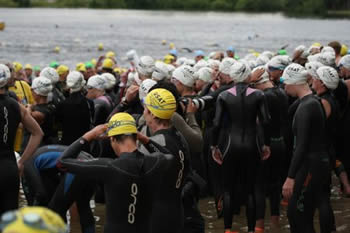 This subject has been written about plenty of times but I thought I’d give you my take on it. First, I’ve been racing since 1983 and have done well over 100 races and I still get nervous. So, if you’re thinking the more you do this the less nervous you’ll get, you’re dreaming.
This subject has been written about plenty of times but I thought I’d give you my take on it. First, I’ve been racing since 1983 and have done well over 100 races and I still get nervous. So, if you’re thinking the more you do this the less nervous you’ll get, you’re dreaming.
Some say the nervousness you feel is a good thing. I don’t know if it is or not. All I know is that I have it. The key thing for me is learning how to channel it and deal with it.
I find that I’m more nervous before “big” races than less important races( DUH!). Makes sense, but if you think about it rationally, this will help reduce the tension before your lesser important races. Stress before the “big” races, not the smaller ones.
Sleep is crucial to performing at your best. The problem is that it’s frequently difficult to sleep the night before a race. So here’s what I do. I aim to sleep as much as possible two nights before the race, knowing that I’m not likely to get too much sleep the night before the race. Then, you’ll at least have some energy still in the tank.
Another ploy I have is to take a nap the day before a race. Now, when I nap I’m only grabbing 20 – 30 minutes. That way it won’t keep me up later that night.
When you’re on the road and sleeping away from your own home it’s best to try to do whatever relaxes you. Go to the spa or steam room, read a book, eat your favorite comfort food, have a glass of beer or wine. Anything that will help you wind down.
So why is it important to get sleep anyway? Won’t the adrenaline carry me through the race? One of the main reasons you want to get plenty of sleep is because the body and mind repair themselves when you’re at rest. If you track your heart rate on a regular basis, notice what your heart rate is when you wake up from a morning of good sleep and another when you didn’t. You’ll find your “resting heart rate” is between 5 to 10 beats faster when you don’t get good rest.
And, yes, the adrenaline may carry you through to the finish but if you’re well rested you’ll always perform better.
RACE PERIOD
Ron Saetermoe
This is what it’s all been leading up to . . . your Race Period. This is when you give your training everything you’ve got. Your volume and intensity max during this period; and it is intense!
While “stuff happens” you really need to try to stay on task during this period. No slacking off now. You may be getting nervous about your race at this point and wondering if your training was adequate. If you’re a typical “A” type triathlon personality you’ll never feel like you’ve done everything you could have to prepare.
You must be very careful during this period NOT to over train, and to make sure you get plenty of rest on your recovery days. Too many athletes think that more is better and while you will be doing more volume you also need to get your rest or all of the hard work simply won’t take.
Go over the race on paper (or computer) and in your head. Review the website and any course maps, rules, directions, etc. Go to the race site in advance if you can and do the course.
I’m going to try to get a slot at IM St. George on May 1st so a bunch of us are going out to St. George to ride and run the course in March. This will give us an edge come race day.
You’ll either pull back on the resistance training or end it all together during this period – you’re probably totally ripped anyway by now! In addition, this phase includes the CRITICAL taper prior to your event.
The length of your taper will depend on the event you’re training for. Here’s what I like to do:
Sprint: 3 days
Olympic: 1 week
½ IM: 2 weeks
IM: 3 weeks
By now you should have your nutrition completely dialed in. Don’t change anything at this late date. Stay focused.
The key things about the Race Period are:
– Don’t miss workouts unless sick or injured
– Continue to increase your training volume and intensity
– Resistance (strength) training ends
– “Brick” workouts should be getting longer in distance
– Recovery is critical
– Taper
Here’s what the ideal Triathica year looks like:

Again, we feel that three, three-week cycles within each period is optimal for building fitness and recovery. The time to build strength, speed and endurance is upon you. Make the best of it!
Cheers!
Ron
BREAKING THROUGH A PLATEAU
Jarrett Pflieger
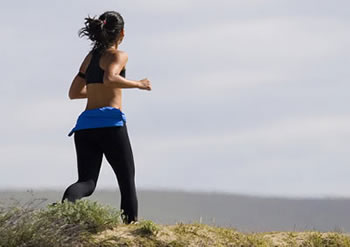
Triathletes are in a constant battle against themselves. We go out and train, beating up our bodies, with the knowledge that all our hard work will translate into adaptations that will enable us to swim, bike, and run faster and longer. There is no greater feeling than continuously going out and improving upon your performances from the weeks, months, and years previous.
Unfortunately, this feeling does not last forever. Every triathlete eventually hits a point where, no matter how hard they train; they can’t seem to improve even a small amount, if at all. This is known as a plateau and is common among all types of athletes. There are several reasons for this and ways to get around plateaus, so there’s no need to panic.
1. Stagnant Training Routines
Many of us like to stay in our comfort zones. We get into a comfortable training routine that we like and have shown us good performance gains in the past. Just because it has worked does not mean it will work forever. Your body is very good at adapting to outside stress, so if you maintain the same routine for months without switching things up, your body will stop responding to the stress and you will not see the gains you want.
To prevent this, you need to change things around every once and a while. When building a training plan, you need to vary not only distance, but also intensity, volume, rest periods, etc. A good periodized training plan should incorporate all these aspects and keep your body constantly guessing.
2. Poor Diet
Your body is a machine and it needs fuel to function properly. This is even more important for athletes. Your performance will reflect the kinds of food you put into it. You should stick with calorically dense foods like fruits, vegetables, complex carbohydrates (oatmeal, whole wheat, brown rice, quinoa, etc.) and lean protein (chicken, fish, lean beef, turkey).
Try to stay away from processed foods and sugars as much as you can. An occasional treat will not hurt, just stick with a 90/10 rule. Follow a sensible diet 90% of the time, and feel free to eat whatever you want 10% of the time, in moderation, of course.
3. Overtraining
The amount of rest you give your body is just as important as your training. Without proper rest, your body will not have time to absorb the training and make the adaptations that lead to increased performance. If you are constantly fatigued, sore, and/or not hitting your target times in training, there is a good chance you are not giving your body enough rest. Too much rest is better than too little. Just listen to your body and dial it back a few notches if you need to. In this case, less is more.
Although there are some reasons for plateaus that cannot be overcome (age, injury, genetics, etc.), most of the time all it takes is a small adjustment in training or lifestyle to keep the gains coming. Listen to your body, get a good coach, and you will continue setting PR’s and getting the most out of your training.
ABOUT THE “BONK”
Ron Saetermoe
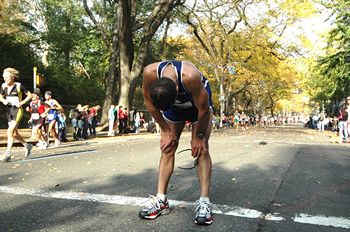 I’m an expert about the “bonk.” Ask me anything!
I’m an expert about the “bonk.” Ask me anything!
For example, did you know there are different kinds of bonk? Sure, you have the nutritional bonk, the cardio bonk, the muscular bonk and the run into the wall bonk. I’ve experienced all four varieties.
One of my Ironman mentors, Chris Johnson (qualified, and completed, 15 consecutive Ironman World Championships) purposely goes out and bonks. This gives him an idea of how hard he can push himself before he bonks. Aren’t we triathletes nutty?
The first time I experienced any kind of bonk was during my first marathon back in 1979. I had heard of “hitting the wall” but didn’t think there was anything you could do about it – it just happens. Of course, I didn’t know back then that it probably would have been a good idea to eat something or at least drink the Gatorade they had on the course.
I bonked in 2008 during my first Ironman: Ironman Coeur d’Alene. This was a muscular bonk. Not to say I wouldn’t have bonked anyway, but I wasn’t able to finish my training plan because I broke two ribs five weeks prior to my race. On second thought, let’s blame it on that.
I bonked again in 2008 at Ironman Arizona. This time it was a nutritional bonk. My personal problem when going hard is taking in anything solid, even gels. For some reason my stomach just doesn’t like anything solid. I had my gels and even made peanut butter and jelly sandwiches but couldn’t stomach any of them.
The bike portion of the race was fine but when I got to the run I was toast! I had nothing in the tank. My legs felt fine and my heart rate was fine but I had no energy. I started walking and was able to pick my pace up throughout the race only because I was able to take some calories in.
Last year Lar Dog, Larry Davidson, turned me on to Infinit. I mix it up to triple strength and sip it and chase it with water. Voila! No bonk! I’ve practiced and raced with it numerous times and not only don’t I bonk but I also don’t get hungry. Problem solved.
I’m sure there are plenty of other fine products out that can perform the same miracles, but for my money, Infinit is it!
BUILD PERIOD
Ron Saetermoe
Last week I discussed the Base Period of your training year, this week we move on to the next period, which is the Build Period.
Once you’ve finished with the Base Period your fitness should be quite good. Now you’re going to continue building your endurance and speed. Your training load increases and missed workouts should be avoided unless sick or injured.
You should still be hitting the gym during this period and increasing the effort in your resistance training. I generally do 10 different exercises in my resistance training – two sets of each exercise. You may be increasing your sets, reps, weight or all three.
Be sure you’re incorporating speed, power and endurance workouts in all three sports during this period, and don’t forget to continue doing bricks (swim/bike and/or bike/run).
During your long rides and runs be sure to test your nutrition and get it completely dialed in so you know what you’ll need to complete your race (if you’re doing the long stuff).
The key things about the Build Period are:
– Don’t miss workouts unless sick or injured
– You continue to increase your training volume and intensity
– Resistance (strength) training increases
– “Brick” workouts should be getting longer in distance
– Don’t forget to incorporate recovery days and weeks in your plan (your fitness takes hold when your body is at rest)
Here’s what the ideal Triathica year looks like:

Again, we feel that three, three-week cycles within each period is optimal for building fitness and recovery. The time to build strength, speed and endurance is upon you. Make the best of it!
Cheers!
Ron
EVERY RUNNERS NIGHTMARE: THE SIDE STITCH
Jarrett Pflieger
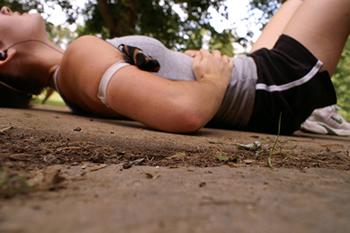 Side stitches, cramps, whatever you want to call them, they hurt. Every runner, at one point of another, has had to battle through a side stitch during training or racing. The pain can become so bad it forces us to slow down, or in extreme cases, stop completely. What exactly causes these side stitches and are there ways to make them go away when they happen, or better yet, prevent them altogether?
Side stitches, cramps, whatever you want to call them, they hurt. Every runner, at one point of another, has had to battle through a side stitch during training or racing. The pain can become so bad it forces us to slow down, or in extreme cases, stop completely. What exactly causes these side stitches and are there ways to make them go away when they happen, or better yet, prevent them altogether?
A side stitch, technically known as exercise-related transient abdominal pain (ETAP), is not a buildup of gas or cramping of the abdominal muscles. It actually originates in the diaphragm, the muscle that helps you breathe and separates your organs from your chest cavity. You see, when you breathe in, your diaphragm naturally moves downward to increase the capacity of air your lungs can take in. As your diaphragm moves up during exhaling, it brings your organs up with it.
The problem is when you run, you have gravity working against you, even more so than when you’re standing still. When you take each stride while running, your organs are pulled down by gravity, but your exhaling causes your diaphragm to move up. These opposing forces cause the ligaments and muscles connecting your organs to your diaphragm to stretch, which is very painful. This phenomenon can then make your diaphragm to go into spasms, which causes the painful cramps we often experience.
Once a side stitch comes, it is hard to get rid of. You can try sticking a few fingers under your ribs to try to massage the muscles and ligaments. Deep breathing also helps get rid of the stitch faster, since shallow breathing usually prolongs the spasming. If all else fails, slow down or stop until the pain leaves. If you are made of steel and feel no pain, just push through it, the choice is yours.
One way to prevent side stitches completely is to change your breathing pattern. If you tend to exhale mostly when your right foot is hitting the ground, your large liver could be causing more pain as it is pulled away from your diaphragm. Organs are smaller on the left side, so try exhaling when on left foot strikes.
Proper hydration and warm-up is also key in preventing the side stitch. Dehydration, sodium deficiency, and cold muscles can make the side stitch come faster and be harder to get rid of. Hopefully you can implement some of these tips and say farewell to your side stitch woes for good.


